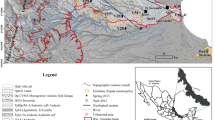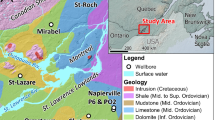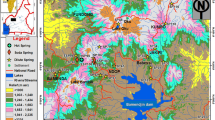Abstract
Determining groundwater ages from environmental tracer concentrations measured on samples obtained from open bores or long-screened intervals is fraught with difficulty because the sampled water represents a variety of ages. A multi-tracer technique (Cl, 14C, 3H, CFC-11, CFC-12, CFC-113 and SF6) was used to decipher the groundwater ages sampled from long-screened production bores in a regional aquifer around an open pit mine in the Pilbara region of northwest Australia. The changes in tracer concentrations due to continuous dewatering over 7 years (2008–2014) were examined, and the tracer methods were compared. Tracer concentrations suggest that groundwater samples are a mixture of young and old water; the former is inferred to represent localised recharge from an adjacent creek, and the latter to be diffuse recharge. An increase in 14C activity with time in wells closest to the creek suggests that dewatering of the open pit to achieve dry mining conditions has resulted in change in flow direction, so that localised recharge from the creek now forms a larger proportion of the pumped groundwater. The recharge rate prior to development, calculated from a steady-state Cl mass balance, is 6 mm/y, and is consistent with calculations based on the 14C activity. Changes in CFC-12 concentrations with time may be related to the change in water-table position relative to the depth of the well screen.
Résumé
La détermination de l’âge des eaux souterraines à partir des concentrations de traceurs environnementaux mesurées sur des échantillons prélevés dans des puits ouverts ou à diverses profondeurs de crépines est difficile du fait que les eaux échantillonnées représentent divers âges. Une technique multi-traceurs (Cl, 14C, 3H, CFC-11, CFC-12, CFC-113 et SF6) a été appliquée afin de différencier les divers âges d’eau souterraine échantillonnée au niveau de longues crépines de forages de production captant l’aquifère régional autour de la mine à ciel ouvert de la région de Pilbara au nord-ouest de l’Australie. Les changements de concentration des traceurs du fait d’un dénoyage continu de la mine depuis sept ans (2008–2014) ont été étudiés et les résultats des différents traceurs comparés entre eux. Les concentrations des traceurs laissent penser que les échantillons d’eau souterraine représentent des mélanges d’eau jeune et ancienne; l’eau jeune étant la recharge par un proche ruisseau et l’eau ancienne représentant la recharge diffuse. Une augmentation de l’activité 14C avec le temps dans les puits proches du ruisseau indique que le dénoyage de la mine à ciel ouvert effectué pour obtenir des conditions d’exploitation à sec a entrainé un changement de la direction d’écoulement; la recharge localisée à partir du ruisseau formant ainsi une plus forte part des eaux souterraines pompées. Le taux de recharge avant l’exploitation, calculé à partir du bilan de masse du chlorure à l’état stationnaire, est de 6 mm/an, et est en accord avec les calculs basés sur l’activité 14C. Les changements temporels des concentrations du CFC-12 peuvent être mis en relation avec les changements du niveau de la nappe par rapport à la profondeur de la crépine.
Resumen
La determinación de edades del agua subterránea a partir de concentraciones de trazadores ambientales medidos en muestras obtenidas de perforaciones abiertas o a lo largo de los intervalos filtrados está llena de dificultades debido a que la muestra de agua representa a diversas edades. Una técnica multi-trazador (Cl, 14C, 3H, CFC-11, CFC-12, CFC-113 y SF6) se utilizó para descifrar las edades del agua subterránea muestreada a lo largo de los filtros de pozos de producción en un acuífero regional en el entorno de una mina a cielo abierto en el región de Pilbara en el noroeste de Australia. Se examinaron los cambios en las concentraciones de los trazadores debido al drenaje continuo durante siete años (2008–2014), y se compararon los métodos de los trazadores. Las concentraciones de los trazadores sugieren que las muestras de agua subterránea son una mezcla de agua joven y vieja; la primera se infiere por representar la recarga localizada de un arroyo adyacente, y la segunda por ser una recarga difusa.
Un aumento en la actividad del 14C con el tiempo en los pozos cercanos al arroyo sugiere que la extracción de agua en la minería a cielo abierto para lograr explotación en seco ha dado lugar a un cambio en la dirección del flujo, por lo que la recarga localizada de la quebrada constituye actualmente la mayor proporción del agua subterránea bombeada. La tasa de recarga previo al desarrollo, calculada a partir de un balance de masas Cl en estado estacionario, es 6 mm/año, y es consistente con los cálculos basados en la actividad de 14C. Los cambios en las concentraciones del CFC-12 con el tiempo pueden estar relacionados con el cambio de posición del nivel freático con relación a la profundidad de los filtros del pozo.
摘要
根据从开口井或滤水管长的间隔地段获取的水样测量环境同位素含量来确定地下水的年龄困难重重,因为所取水样展现出年龄差别很大。采用多重示踪剂技术((Cl、 14C、 3H、 CFC-11、 CFC-12、 CFC-113 和 SF6)解译了澳大利亚西北部皮尔布拉地区露天矿周边区域含水层长滤水管生产井中水样的地下水年龄。调查了由于连续七年排水导致的示踪剂含量变化(2008–2014年),对示踪剂方法进行了比较。示踪剂含量表明地下水是年轻水和年老水的混合水;推断前者是来自毗邻小溪的本地化的补给水,而后者为弥散补给水。小溪最近处的井水14C活性随时间增加表明,露天矿坑排水实现采矿条件干燥导致了水流方向的改变,因此,抽取的地下水中很大一部分就是来自小溪的本地化补给水。通过稳定态Cl质量平衡计算得到的开采前补给量为6 mm/y,与基于14C活性的计算结果一致。CFC-12含量随时间的变化可能与相对于水井滤水管的深度来说水位的变化有关。
Resumo
Determinar a idade das aguas subterrâneas a partir das concentrações de traçadores ambientais medidas em amostras obtidas de furos de sondagem ou longas seções filtrantes é repleto de dificuldades, pois a água amostrada representa uma variedade de idades. Uma técnica de multi-traçador (Cl, 14C, 3H, CFC-11, CFC-12, CFC-113 e SF6) foi usada para decifrar a idade das águas subterrâneas amostradas em poços de produção com filtros longos próximos a uma mina a céu aberto na região de Pilbara, Noroeste da Austrália. A mudança nas concentrações do traçador devido à retirada continua de água ao longo de sete anos (2008–2014) foi investigada, e os métodos de traçadores foram comparados. As concentrações de traçadores sugerem que as amostras de águas subterrâneas são uma mistura entre águas jovens e antigas. Foi inferido que a primeira representa a recarga localizada de um córrego adjacente, e a última a recarga difusa. Um aumento na atividade de 14C com o tempo em poços próximos ao córrego sugerem que a drenagem das minas para alcançar uma condição seca de mineração resultou em uma mudança na direção do fluxo, de modo que a recarga localizada do córrego agora constitui uma grande proporção das águas subterrâneas bombeadas. A taxa de recarga anterior ao desenvolvimento, calculada através de um balanço de massa de Cl em regime permanente, é 6 mm/ano, e é coerente com os cálculos baseados na atividade de 14C. Mudanças nas concentrações de CFC-12 com o tempo podem estar relacionadas a mudanças na posição do nível freático relativos à profundidade do filtro do poço.











Similar content being viewed by others
References
Allison GB, Gee GW, Tyler SW (1994) Vadose-zone techniques for estimating groundwater recharge in arid and semiarid regions. Soil Sci Soc Am J 58(1):6–14
Becker RH, Clayton RN (1972) Carbon isotopic evidence for the origin of a banded iron formation in Western Australia. Geochim Cosmochim Acta 36:577–595
Böhlke JK, Revesz K, Busenberg E, Deak J, Deseo E, Stute M (1997) Groundwater record of halocarbon transport by the Danube River. Environ Sci Technol 31(11):3293–3299
BOM (2016) Climate statistics for Australian locations. http://www.bom.gov.au/climate/averages/tables/cw_007151.shtml. Australian Government, Bureau of Meteorology. Accessed 29 July 2016
Bourke SA, Cook PG, Shanafield M, Dogramaci S, Clark JF (2014) Characterisation of hyporheic exchange in a losing stream using radon-222. J Hydrol 519:94–105
Bu X, Warner MJ (1995) Solubility of chlorofluorocarbon 113 in water and seawater. Deep-Sea Res 42(7):1151–1161
Bullister JL, Wisegarver DP, Menzia FA (2002) The solubility of sulfur hexafluoride in water and seawater. Deep-Sea Res 49:175–187
Busenberg E, Plummer LN (1992) Use of chlorofluorocarbons (CCl3F and CCl2F2) as hydrologic tracers and age-dating tools: the alluvium and terrace system of central Oklahoma. Water Resour Res 28(9):2257–2283
Busenberg E, Plummer LN (2000) Dating young groundwater with sulfur hexafluoride: natural and anthropogenic sources of sulfur hexafluoride. Water Resour Res 36(10):3011–3030
Cerling TE, Quade J (1993) Stable carbon and oxygen isotopes in soil carbonates. In: Climate change in continental isotopic records. Geophysical Monograph 78, American Geophysical Union, Washington, DC, pp 217–231
Clark ID, Fritz P (1997) Environmental isotopes in hydrogeology. Lewis, Boca Raton, FL
Cook PG, Bohlke JK (2000) Determining timescales for groundwater flow and solute transport. In: Cook PG, Herczeg AL (eds) Environmental tracers in subsurface hydrology. Kluwer, Boston, pp 1–30
Cook PG, Solomon DK (1995) The transport of atmospheric trace gases to the water table: implications for groundwater dating with chlorofluorocarbons and krypton-85. Water Resour Res 31:263–270
Cook PG, Solomon DK (1997) Recent advances in dating young groundwater: 3H/3He, chlorofluorocarbons and 85Kr. J Hydrol 191:245–265
Cook PG, Solomon DK, Plummer LN, Busenberg E, Schiff SL (1995) Chlorofluorocarbons as tracers of groundwater transport processes in a shallow, silty sand aquifer. Water Resour Res 31(3):425–434
Cook PG, Love AJ, Robinson NI, Simmons CT (2005) Groundwater ages in fractured rock aquifers. J Hydrol 308:284–301
Cornaton FJ (2012) Transient water age distributions in environmental flow systems: the time-marching Laplace transform solution technique. Water Resour Res 48(3). doi:10.1029/2011WR010606
Cunnold DM, Fraser PJ, Wiess RF, Prinn RG, Simmonds PG, Miller BR, Alyea FN, Crawford AJ (1994) Global trends and annual releases of CCl3F and CCl2F2 estimated for ALE/GAGE and other measurements from July 1978 to June 1991. J Geophys Res Atmos 99(D1):1107–1126
Dogramaci S, Skrzypek G, Dodson W, Grierson PF (2012) Stable isotope and hydrochemical evolution of groundwater in the semi-arid Hamersley Basin of subtropical northwest Australia. J Hydrol 475:281–293
Dogramaci S, Firmani G, Hedley P, Skrzypek G, Grierson PF (2015) Evaluating recharge to an ephemeral dryland stream using a hydraulic model and water, chloride and isotope mass balance. J Hydrol 521:520–532
Dunkle SA, Plummer LN, Denver JM, Hamilton PA, Michel RL, Coplen TB (1993) Chlorofluorocarbons (CC13F and CC12F2) as dating tools and hydrologic tracers in shallow groundwater of the Delmarva Peninsula, Atlantic Coastal Plain, United States. Water Resour Res 29(12):3837–3860
Eberts SM, Kauffman LJ, Jurgens BC (2012) Comparison of particle-tracking and lumped-parameter age-distribution models for evaluating vulnerability of production wells to contamination. Hydrogeol J 20:263–282
Ekwurzel B, Schlosser P, Smethie WM, Plummer LN, Busenberg E, Michel RL, Weppernig R, Stute M (1994) Dating of shallow groundwater: comparison of the transient tracers 3H/3He, chlorofluorocarbons, and 85Kr. Water Resour Res 30(6):1693–1708
Heaton THE, Vogel JC (1981) “Excess air” in groundwater. J Hydrol 50:201–216
Hinsby K, Hojberg AL, Engesgaard P, Jensen KH, Larsen F, Plummer LN, Busenberg E (2007) Transport and degradation of chlorofluorocarbons (CFCs) in the pyritic Rabis Creek aquifer, Denmark. Water Resour Res 43(10). doi: 10.1029/2006WR005854
Ingerson R, Pearson FJ (1964) Estimation of age and rate of motion of groundwater by the 14C method. In: Miyake Y, Koyama T (eds) Recent research in the field of hydrosphere. In: Atmosphere and nuclear geochemistry. Marusen, Tokyo, pp 263–283
Johnston CT, Cook PG, Frape SK, Plummer LN, Busenberg E, Blackport RJ (1998) Groundwater age and nitrate distribution within a glacial aquifer beneath a thick unsaturated zone. Groundwater 36(1):171–180
Jurgens BC, Bexfield LM, Eberts SM (2014) A Ternary age-mixing model to explain contaminant occurrence in a deep supply well. Groundwater 52:25–39
Leray S, de Dreuzy JR, Aquilina L, Vergnaud-Ayraud V, Labasque T, Bour O, Le Borgne T (2014) Temporal evolution of age data under transient pumping conditions. J Hydrol 511:555–566
Levin I, Bösinger R, Bonani G, Francey RJ, Kromer B, Munnich KO, Suter M, Trivett NBA, Wölfli W (1992) Radiocarbon in atmospheric carbon dioxide and methane: global distribution and trends. In: Taylor RE, Long A, Kra RS (eds) Radiocarbon after four decades, Springer, Heidelberg, Germany, pp 503–518
Manning AH, Clark JF, Diaz SH, Rademacher LK, Earman S, Plummer LN (2012) Evolution of groundwater age in a mountain watershed over a period of thirteen years. J Hydrol 460–461:13–28
Massoudieh A (2013) Inference of long-term groundwater flow transience using environmental tracers: a theoretical approach. Water Resour Res 49(12):8039–8052
Mayo AL (2010) Ambient well-bore mixing, aquifer cross-contamination, pumping stress and water quality from long-screened wells: what is sampled and what is not? Hydrogeol J 18(4):823–827
McCallum JL, Engdahl NB, Ginn TR, Cook PG (2014) Non-parametric estimation of groundwater residence time distributions: what can environmental tracer data tell us about groundwater residence time? Water Resour Res 50(3):2022–2038
McMahon PB, Plummer LN, Bohlke JK, Shapiro SD, Hinkle SR (2011) A comparison of recharge rates in aquifers of the United States based on groundwater-age data. Hydrogeol J 19(4):779–800
Morgenstern U, Taylor CB (2009) Ultra low-level tritium measurement using electrolytic enrichment and LSC. Isotopes Environ Health Stud 45(2):96–117
Pearson FJ, White DE (1967) Carbon 14 ages and flow rates of water in Carrizo Sand, Atascosa County, Texas. Water Resour Res 3(1):251–261
Robertson WD, Cherry JA (1989) Tritium as an indicator of recharge and dispersion in a groundwater system in central Ontario. Water Resour Res 25(6):1097–1109
Sebol LA, Robsertson WD, Busenberg E, Plummer LN, Ryan MC, Schiff SL (2007) Evidence of CFC degradation in groundwater under pyrite-oxidizing conditions. J Hydrol 347(1–2):1–12
Solomon DK, Cook PG (1999) 3H and 3He. In: Cook PG, Herczeg AL (eds) Environmental tracers in subsurface hydrology. Kluwer, Boston, pp 397–424
Solomon DK, Sudicky EA (1991) Tritium and helium-3 isotopic ratios for direct estimation of spatial variations in groundwater recharge. Water Resour Res 27(9):2309–2319
Solomon DK, Hunt A, Poreda RJ (1996) Source of radiogenic helium 4 in shallow aquifers: implications for dating young groundwater. Water Resour Res 32(6):1805–1813
Stuiver M, Polach HA (1977) Discussion: reporting of carbon-14 data. Radiocarbon 19:355–363
Tadros CV, Hughes CE, Crawford J, Hollins SE, Chisari R (2014) Tritium in Australian precipitation: a 50 year record. J Hydrol 513:262–273
Tamers MA (1967) Radiocarbon ages of groundwater in an arid zone unconfined aquifer. In: Isotope techniques in the hydrological cycle. AGU Monograph 11, AGU, Washington, DC, pp 3–152
Varni M, Carrera J (1998) Simulation of groundwater age distributions. Water Resour Res 34(12):3271–3281
Visser A, Broers HP, Purtschert R, Sultenfuβ J, de Jonge M (2013) Groundwater age distributions at a public drinking water supply well field derived from multiple age tracers (85Kr, 3H/3He, 39Ar). Water Resour Res 49:7778–7796. doi:10.1002/2013WR014012
Vogel JC (1967) Investigation of groundwater flow wit radiocarbon. In: Isotopes in hydrology. IAEA, Vienna, pp 355–369
von Rohden C, Kreuzer A, Chen Z, Aeschbach-Hertig W (2010) Accumulation on natural SF6 in the sedimentary aquifers of the North China Plain as a restriction on groundwater dating. Isot Environ Health Stud 46(3):279–290
Walker GR, Cook PG (1991) The importance of considering diffusion when using carbon-14 to estimate groundwater recharge. J Hydrol 128:41–48
Warner MJ, Weiss RF (1985) Solubilities of chlorofluorocarbons 11 and 12 in water and seawater. Deep-Sea Res 32(12):1485–1497
Weissmann GS, Zhang Y, Labolle EM, Fogg GE (2002) Dispersion of groundwater age in an alluvial aquifer system. Water Resour Res 38(10):1198. doi:10.1029/2001WR000907
Acknowledgements
This work was undertaken as part of a collaborative project between the National Centre for Groundwater Research and Training (NCGRT) and Rio Tinto Iron Ore. Funding was provided by the Australian Research Council, through Linkage Grant LP150100395 and by Rio Tinto Iron Ore. We thank several members of our teams at RTIO and Flinders University whose work made this study possible, especially Glenn Kirkpatrick for assistance in the field, Maree Swebbs and Thomas Linklater for help with the map preparations.
Author information
Authors and Affiliations
Corresponding author
Rights and permissions
About this article
Cite this article
Cook, P., Dogramaci, S., McCallum, J. et al. Groundwater age, mixing and flow rates in the vicinity of large open pit mines, Pilbara region, northwestern Australia. Hydrogeol J 25, 39–53 (2017). https://doi.org/10.1007/s10040-016-1467-y
Received:
Accepted:
Published:
Issue Date:
DOI: https://doi.org/10.1007/s10040-016-1467-y




